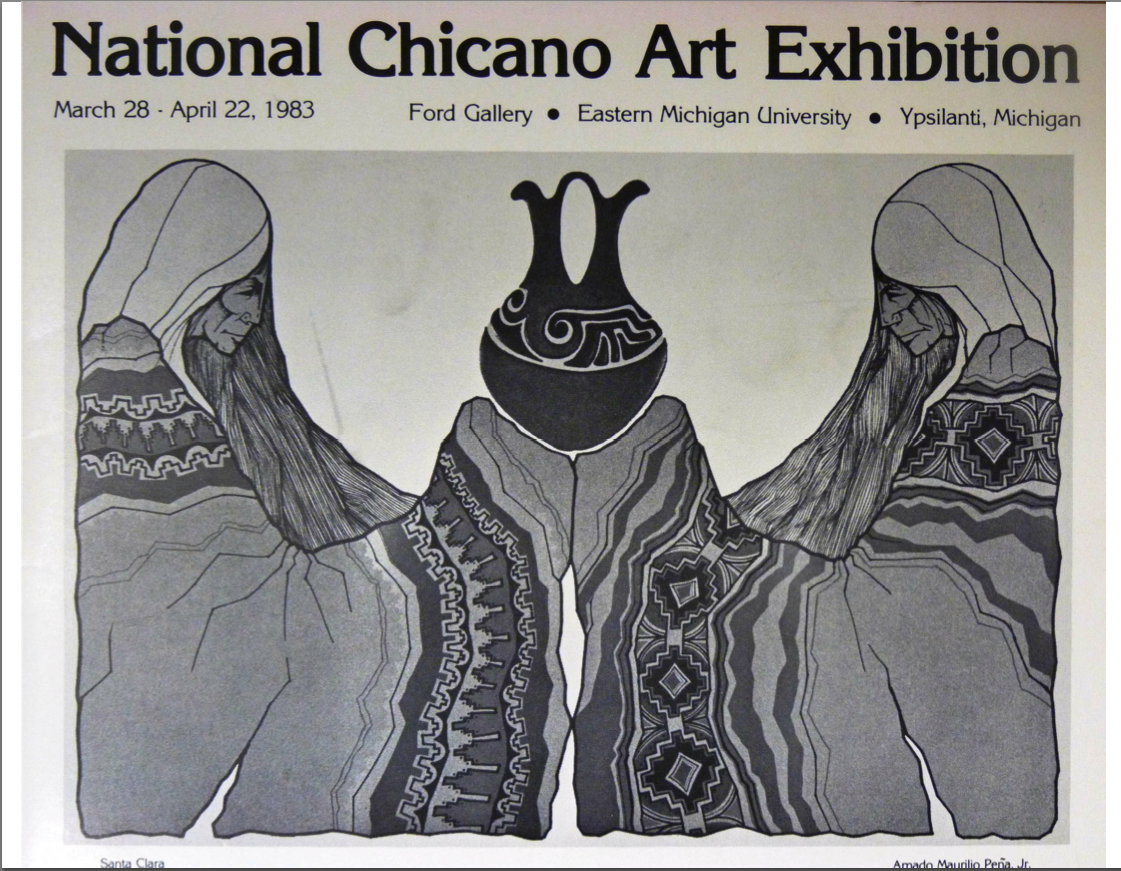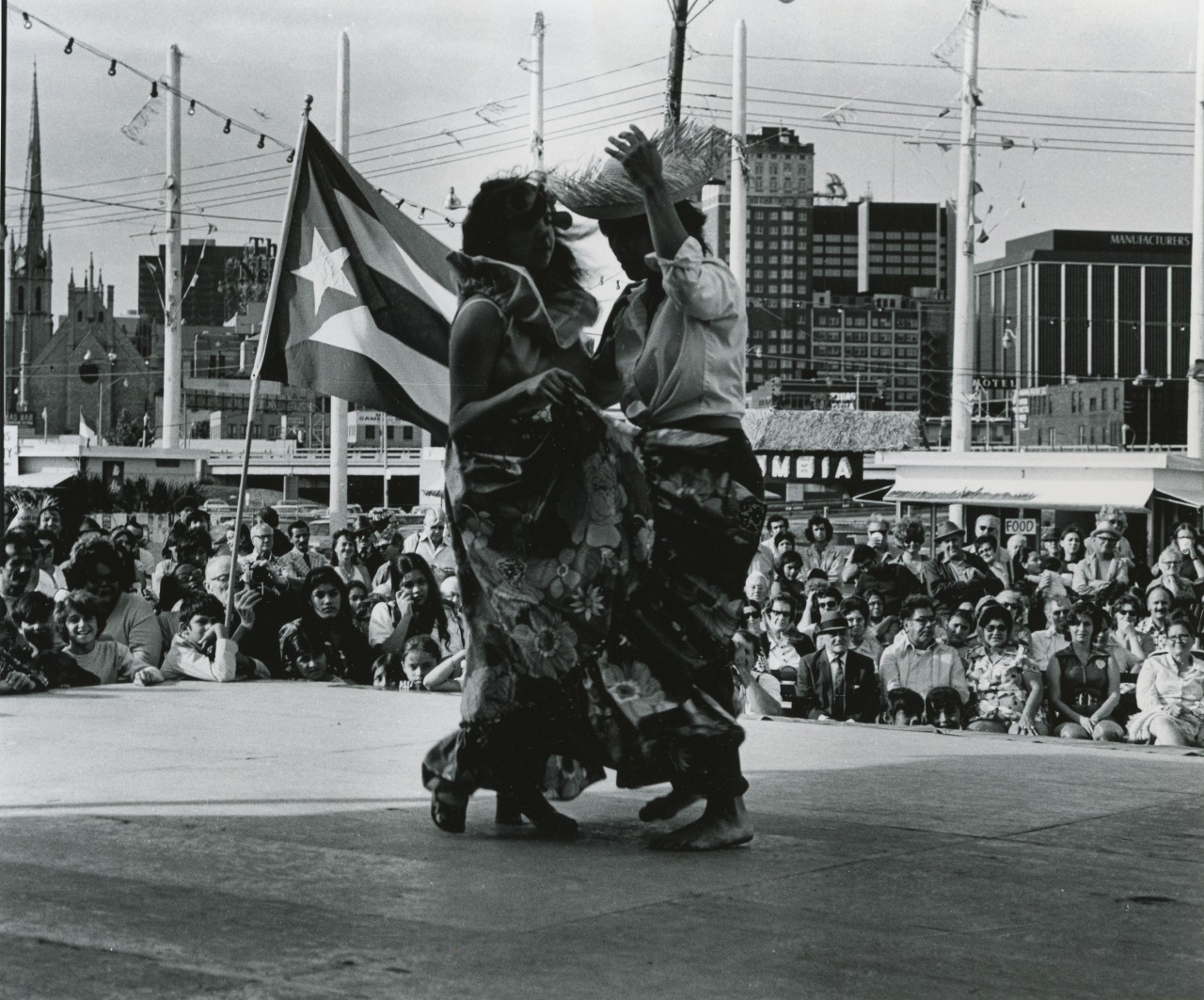This Historia was researched and created by CPMR Intern Marie Dillivan.
The Raza Art and Media Collective was founded at the University of Michigan in Ann Arbor in 1974. The group’s founders were University of Michigan students with backgrounds in art, art history, community education, film, photograph, and journalism [1]. They included Ana Luisa Cardona, Michael J. Garcia, Jesse Gonzales, George Vargas, Julio Perazza, S. Zaneta Kosiba Vargas, and Zaragosa Vargas [2]. Ana Cardona described the organization as a “not for profit organization devoted to the creation and documentation of the arts and media by and for the Spanish-speaking and non-Spanish-speaking communities”[3]. While the members were mostly Chicana/o students at the University of Michigan, Cardona and Perazza were both Puerto Rican, reflecting the diversity of the Latina/o demographics of the Midwest. The Collective organized themselves as a student organization at the University of Michigan, which included benefits such as office space and funding [4]. They also secured funding through community fundraising activities and grants from the Michigan Council for the Arts and, later, the Literature Program of the National Endowment for the Arts [5].
The Raza Art and Media Collective came into existence during a particularly tumultuous political and social moment on the campus of the University of Michigan and in the United States as a whole. This period—which witnessed the radicalization of the Civil Rights Movement, the Feminist Movement, the Chicano Movement, the Anti-War Movement, and the Student Movement—“brought national issues of poverty, urban crisis, repression, discrimination, racial and ethnic tensions” among other social issues to the attention of the general population [6]. In response to this changing political and social climate on the University’s campus and in the nation, the Raza Art and Media Collective was formed with the intent to combat stereotypes about Latina/os and provide a platform for art that had been previously less widely visible.
The RAM Collective responded to the increased activity of Latino and Latin American artists in the Midwest and the social and political issues of the Chicano movement. The Collective’s connections with other art collectives around the United States have been documented in an essay by Olga U. Herrera, which discusses the Collective’s connections with Con Safos and Asco. These connections provided inspiration for their art and helped them to figure out how to combat stereotypes of Chicano and Latino art in general. Their goal in creating a platform and resource for “Raza art” was to provide an inclusive space for Latina/o artists of all backgrounds, for both Spanish-speaking and non-Spanish-speaking artists and audiences, and for Latina/os in Michigan specifically. Central to this objective was the Raza Art and Media Collective Journal, which sought to give a voice and a platform to Chicano and Latino artists in the Midwest. Ana Cardona indicated that the group immediately went into “publication mode” once they organized because they felt that there was a crucial need for material on Chicano and Latino art [7]. The RAM Collective gathered outside submissions along with the work of the members to create a total of four issues of the RAM Collective Journal from 1976-1977.
Despite its relatively short run, the impact and influence of the journal was far-reaching because it was a critical platform for Latina/o artists in the Midwest during a period when Latina/o art itself was understudied and when the contributions of the Midwest to Latina/o art and literature were fairly unacknowledged. The Raza Art and Media Collective received support for its Journal from universities and departments around the country, including subscription requests and letters of support from UCLA, Indiana University, and Stanford University throughout 1976. A sample of the letters of support for the RAMC Journal from around the country shows the importance of the Journal at the time for Hispanic/Chicano/Latino Studies departments as they were provided with a resource to help introduce their students to Latino art. They also show the wide reach that the Journal had beyond its own community and university, allowing both the artists and the subject of Latina/o art to gain national recognition.

Unfortunately, despite widespread support, the last edition of the Raza Art and Media Collective Journal was in 1977. Members of the RAM Collective eventually moved into other phases of their lives, as university students do, and on to other areas of Latina/o arts advocacy in Michigan and elsewhere. The history and impact of the Raza Art and Media Collective and its Journal has been only partially documented. Karen Mary Davalos provides an accurate summary of how the Collective established themselves as part of the national fabric of the Chicano arts movement while remaining open regarding the aesthetic, conceptual and ideological boundaries of “Raza art.” She notes: “The rejection of a ‘strict Chicano or Latino/Raza aesthetic’ allowed these Midwestern groups to support the Chicano nationalist project of self-determination and empowerment and position themselves as an ‘integral part of Aztlán’ while remaining inclusive of artists whose identities were not Chicano” [8]. With only four issues of the journal, the Collective was able to help to fill a void and make themselves and their art visible around the country while promoting their efforts to bring more visbility, and inclusivity, to Latino art. The fact that the group achieved national recognition and success in such a short period of time and with such a small amount of resources is indicative of the contemporary need for material on the subject of Chicano and Latino art.
[1] Olga U. Herrera "Raza Art and Media Collective: A Latino Art Group in the Midwestern United States." Institute for Latino Studies, University of Notre Dame: 32.
[2] The Raza Art and Media Collective Journal I, no. 1 (1976): 1.
[3] “Ana Cardona CV.” Ana Cardona Archive, Chicana Por Mi Raza, 1979. Medici.
[4] “Ana Cardona Oral History.” Ana Cardona Archive, Chicana Por Mi Raza, 2015. Medici.
[5] “Ana Cardona CV”, Chicana Por Mi Raza
[6] Herrera, “Raza Art and Media Collective,” 31.
[7] Herrera, “Raza Art and Media Collective,” 31.
[8] Karen Mary Davalos, Exhibiting Mestizaje: Mexican (American) Museums in the Disapora (Albuquerque: University of New Mexico Press, 2000), 78.
Listen to more of the RAMC Story in Ana Cardona's Own Words:
Further Learning:
Curious to learn more about the artwork of the artists' of the Raza Art and Media Collective? Or perhaps your interest in Chicano Arts in Detroit is piqued? If so, check out, CPMR partner archive El Museo del Norte's Tumblr site featuring an exibition of Julio Perazza's work.
Two people dancing at an event celebrating Puerto Rican culture by Julio Perazza.

